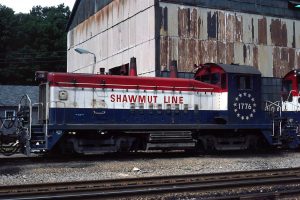- Size: 10′ x 14′
- Scale: HO
- Minimum Radius: 24″
- Minimum Aisle Width: 35″
- Designed by Dan Bourque
Mahoning Yard on the Pittsburg & Shawmut in the rolling hills of western Pennsylvania was where the three-mile long Widnoon Branch (formerly Tidal Branch) split from the mainline along Mahoning Creek. Mahoning was also the dividing point between the two locals that worked the P&S–the Kittanning Local from the south and the Brookville Local from the north. During the 1970s, the branch served two loaders reached via a three percent grade. Additionally, a shorter branch across the creek to Carpentertown served a bank of modern coke ovens later converted to a trump dump tipple.
The Layout
This track plan represents the area around Mahoning Yard including a small portion of the mainline and the two branches. It’s designed to fit into a bedroom-sized space, so curves are tight but wouldn’t present a problem for the P&S’ fleet of SW9s that worked this area. Front-and-center is the tiny Mahoning Yard and its scale track. The Widnoon Branch, line the prototype, climbs steeply up the side of the hill behind the yard before diverging. In reality, the loader at Reddinger was further up the branch and closer to Widnoon, but operationally it works better separated from the end of the branch. The tracks for both loaders were simple affairs. The Carpentertown Branch is also represented, though the short trestle across Mahoning Creek is compressed a bit, as are the coke ovens and tipple tracks.
Staging consists of four double-ended tracks below the layout. They would be hidden and difficult to reach, but if this presents a problem, there is room for two short helixes on either end of the layout to lower the staging tracks and create easier access. The Widnoon Branch is designed to be partially hidden by a low backdrop behind the scale house at Mahoning due to the shallow depth of the layout in this area, though if you had more room, the branch could be perched high up on the hillside. The visible ends of the mainline are hidden by curving behind the hillsides as there were no tunnels or overpasses nearby. Construction would be straightforward using open grid or L-girder benchwork. This layout could easily be run using an entry-level DCC system, though walk-around throttles would be very helpful.
Operations
Operations on this layout would keep 1-2 operators busy for an hour or two. On the prototype, this area was worked by two locals and traversed by two through trains, all of which could be modeled and run here. Mahoning Yard was as far north as the Kittanning Local ran, and Mahoning Yard was typically the southern turn-around point for the Brookville Local. Either local could be used to work the Widnoon Branch, though it probably would depend on which direction the coal was headed. Coal bound for the north and east could be handled by the Brookville Local while coal and coke bound for Pittburgh and points south and west could be handled by the Kittanning local which usually worked Carpentertown (coke headed toward Pittsburgh steel mills). The locals didn’t normally meet in Mahoning, so only one would work the area at a time. Typical power for the locals was 2-3 of the P&S’ SW9s.

Pittsburg & Shawmut SW9 1776 in red-white-and-blue at Brookville, PA -J. R. Quinn (Dan Bourque collection)
My recommendation for this layout is to have the Brookville Local work the Widnoon Branch. The Widnoon Branch was always worked with the engines downgrade. This means the Brookville Local would have to run around its train at Mahoning to put the cab first heading up the branch. In addition to keeping the cars in check on the steep grade, stub tracks at both loaders also necessitated this arrangement. Tipples would take extra moves to work because loads would need to be cleared out before empties could be spotted. Once back in Mahoning with the loads, the job could be extended by weighing all the cars on the scale track. Any cars bound for Kittanning and points south would be left in one of the yard tracks for the Kittanning Local before heading back to Brookville.
The second job would be the Kittanning Local which would arrive with a string of empties and perhaps a handful of loads on their way north. This local would work the coke tracks at Carpentertown again pulling loads first before placing empties because of the stub tracks. The Kittanning Local would leave any northbound cars at Mahoning and add any additional southbound cars to its train before heading back to Kittanning.
The final two jobs would be the “rounders.” The North Rounder and South Rounder were the through trains each day that took cars north and south across the railroad to interchanges with the Pennsy/Penn Central/Conrail and B&O/CSX on the south end and Pennsy/Penn Central/Conrail and Erie/Erie-Lackwanna/Conrail on the north end. This traffic was mostly coal, but a few non-coal industries would see boxcars, tank cars and covered hoppers traversing the road. These trains could stop in Mahoning to pick up any remaining cars heading their direction. Between these four trains, operations sessions could be varied with directions of coal movement and sequence of trains to add variety.
Things I Like About this Plan:
- Continuous running
- Good mix of mainline and branch operations
- Very small yard fitting for this space
- Ability to model every train on the P&S in a small space
Things I Don’t Like About this Plan:
- Hidden staging yard
- Unrelated scenes stacked on top of one another (Widnoon and Mahoning)
- Compressed tracks and tight curves
Related Products:





Pingback: P&S South End, PA track plan HO – Appalachian Railroad Modeling
Pingback: ARRM Welcomes the Pittsburg & Shawmut – Appalachian Railroad Modeling